I held off writing this blog for about two years because I simply couldn’t decide which one of two legends fits better and I was hoping to find something definite that would lead me to one or the other (or to a third interpretation if the first two weren’t correct). Unfortunately, almost nothing about the Voynich is definite except its enigmatic nature, so if I wait for a revelation, this might never get posted.
So here we go, I’ll post both alternatives and let the reader decide if one or the other (or neither) has any validity. Here’s the central part of the image (folio 77v):
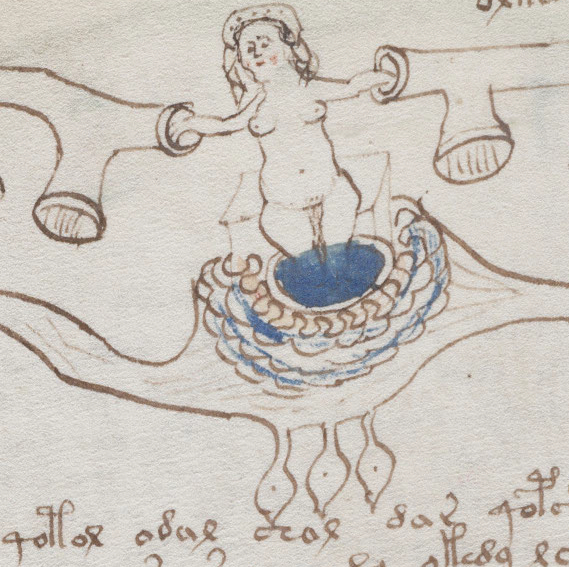 There are some pipe-like biological structures connecting various figures and the maiden is standing in some kind of “pool” (perhaps bodily fluids?) with three pendant shapes below her. At a glance, the image could be interpreted as a womb in the center with ovaries to either side, but could it mean something else, or have a dual meaning?
There are some pipe-like biological structures connecting various figures and the maiden is standing in some kind of “pool” (perhaps bodily fluids?) with three pendant shapes below her. At a glance, the image could be interpreted as a womb in the center with ovaries to either side, but could it mean something else, or have a dual meaning?
Diana or Sabine?
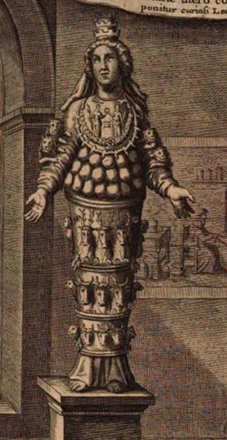 When I first saw this VMS page, it reminded me of two things. The first was the Ephesian Diana. I have a multitude of pictures of Diana and the evolution of her image from the early days of fancy necklaces to symbols of plenitude (acorns and possibly bull’s testicles) to the inevitable depiction of Diana with a multitude of breasts rather than testicles, ready to feed the world. The version of Diana at the Via d’Este displays a chest full of breasts. The image on the right, from one of Athanasius Kircher’s books, is not as clear, but might be testicles. The appendages under the central figure in the VMS could be interpreted as either testicles or breasts.
When I first saw this VMS page, it reminded me of two things. The first was the Ephesian Diana. I have a multitude of pictures of Diana and the evolution of her image from the early days of fancy necklaces to symbols of plenitude (acorns and possibly bull’s testicles) to the inevitable depiction of Diana with a multitude of breasts rather than testicles, ready to feed the world. The version of Diana at the Via d’Este displays a chest full of breasts. The image on the right, from one of Athanasius Kircher’s books, is not as clear, but might be testicles. The appendages under the central figure in the VMS could be interpreted as either testicles or breasts.
But… I wasn’t sure this was a metaphor for Diana, and the ejaculating phallus in the left-hand margin seemed to suggest something other than goddess worship (which was a sacred rather than a carnal adoration to many of the ancients). It’s possible this page is about procreation and insemination, fertility and abundance, as befits Diana, but maybe there’s another explanation…
A More Primal Interpretation
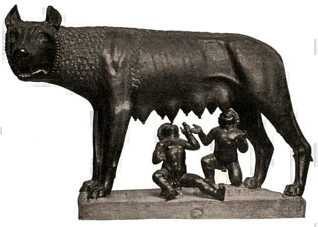 The second idea that came to mind at almost the same moment as the first was this… Could those pendant shapes represent animal teats and thus be a reference to Rome? They reminded me of the she-wolf suckling Romulus and Remus, the twins who had a disagreement over where to place their new city, an altercation that led to Romulus killing his brother Remus so he could have his way.
The second idea that came to mind at almost the same moment as the first was this… Could those pendant shapes represent animal teats and thus be a reference to Rome? They reminded me of the she-wolf suckling Romulus and Remus, the twins who had a disagreement over where to place their new city, an altercation that led to Romulus killing his brother Remus so he could have his way.
If the pendant shapes weren’t breasts or testicles as would be associated with the goddess Diana, could they be the teats of the she-wolf that fed Romulus and Remus? Is this a reference to the founding of Rome or to the capture of Rome in the 8th century BCE?
If so, then perhaps the VMS is allegorical imagery of the abduction of the Sabine women. I searched for a picture that might express the same ideas as the VMS, but in a more literal way and found this 18th-century painting by Jacques-Louis David:
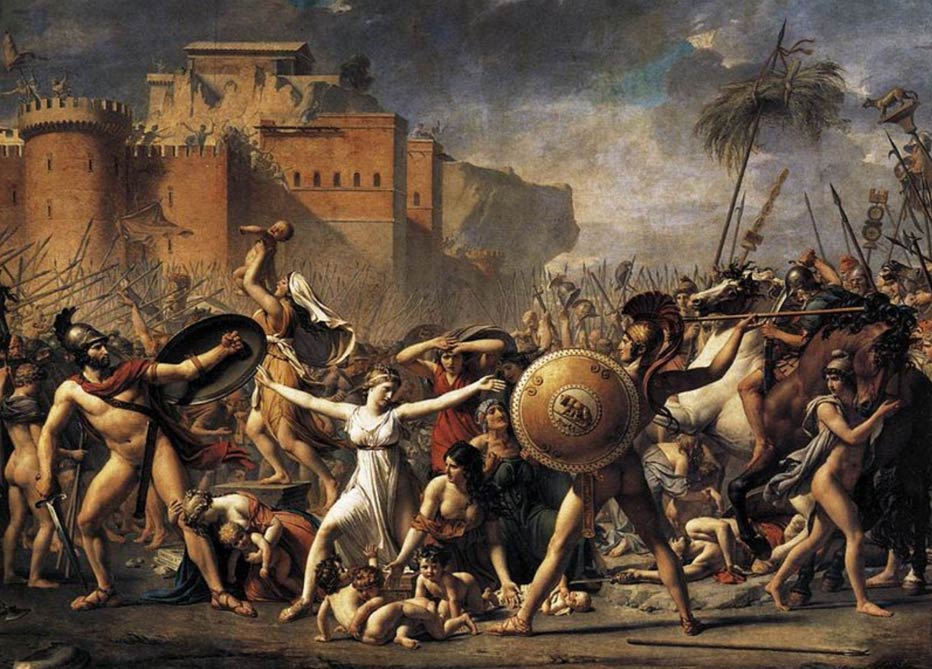 Note how the posture of the maiden trying to intervene in a battle somewhat echoes the arms-wide pose of the nymph in the VMS:
Note how the posture of the maiden trying to intervene in a battle somewhat echoes the arms-wide pose of the nymph in the VMS:
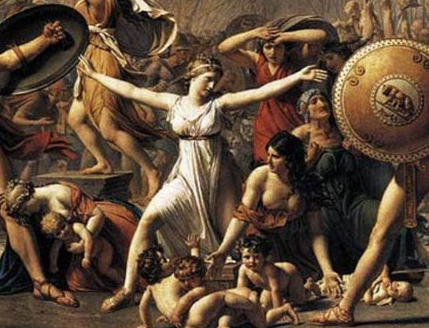 This might fit the VMS imagery more closely than the story of Diana. It could also explain the ejaculating phallus in the margin. Technically, the legend of the Sabines is about the abduction of the Sabine women, not the rape of the Sabines, but how often in history have warriors abducted women without an expectation of having sex with them, especially when they were kidnapping them expressly to take them as wives? Note also that two of the nymphs at the top are wearing veils. There are other places in the VMS where veils are associated with marriage-related imagery, but I’m not sure of their intended meaning here.
This might fit the VMS imagery more closely than the story of Diana. It could also explain the ejaculating phallus in the margin. Technically, the legend of the Sabines is about the abduction of the Sabine women, not the rape of the Sabines, but how often in history have warriors abducted women without an expectation of having sex with them, especially when they were kidnapping them expressly to take them as wives? Note also that two of the nymphs at the top are wearing veils. There are other places in the VMS where veils are associated with marriage-related imagery, but I’m not sure of their intended meaning here.
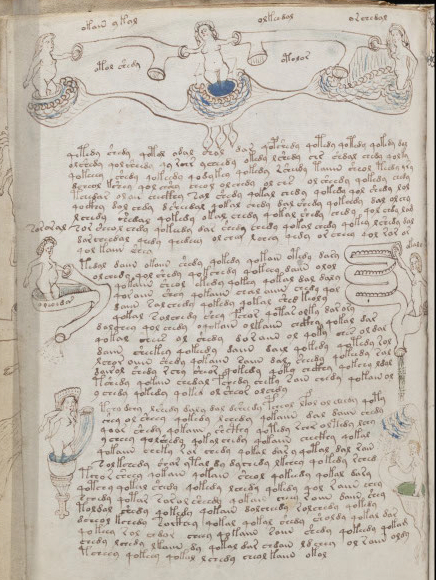 The story of the she-wolf and the founding of Rome might account for the dangly bits below the nymph’s feet (rather than being on her chest as might be expected if she were Diana) and the nymph with chin up and arms spread might represent the Sabine women who cast themselves between opposing forces, willing to die rather than to subject themselves to impious relationships with their kidnappers, an action that supposedly ended the battle and forged a truce between the Sabines and the new colonists.
The story of the she-wolf and the founding of Rome might account for the dangly bits below the nymph’s feet (rather than being on her chest as might be expected if she were Diana) and the nymph with chin up and arms spread might represent the Sabine women who cast themselves between opposing forces, willing to die rather than to subject themselves to impious relationships with their kidnappers, an action that supposedly ended the battle and forged a truce between the Sabines and the new colonists.
Either way, it’s another example of a page where biological imagery and mythical imagery might both be intended. If so, they are expressed in an obtuse but rather original way.
J.K. Petersen
© Copyright 2016 J.K. Petersen, All Rights Reserved
